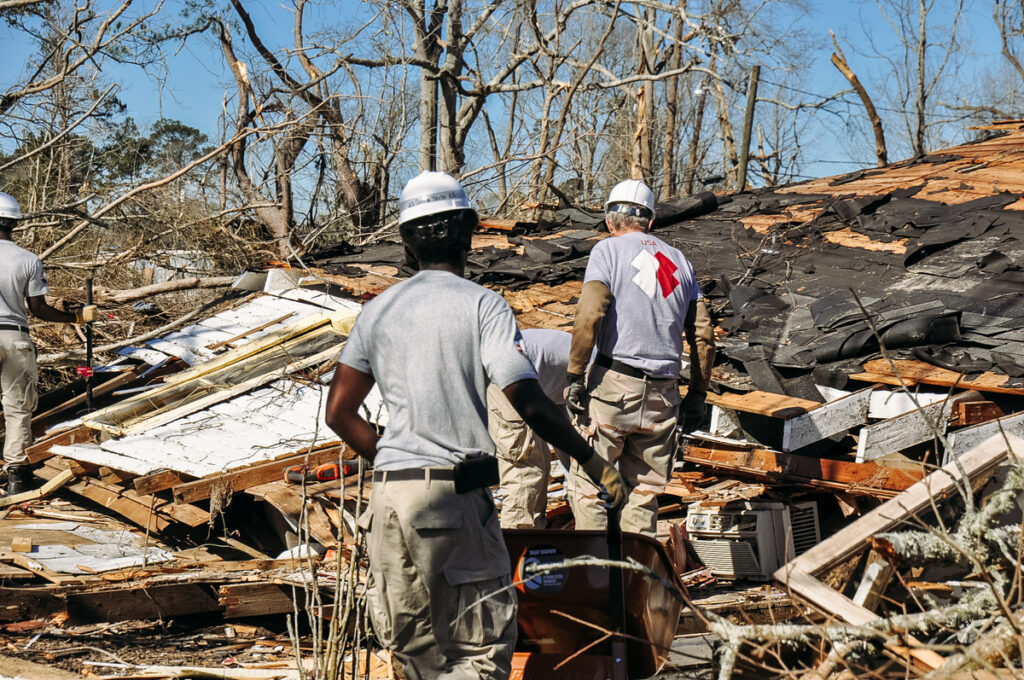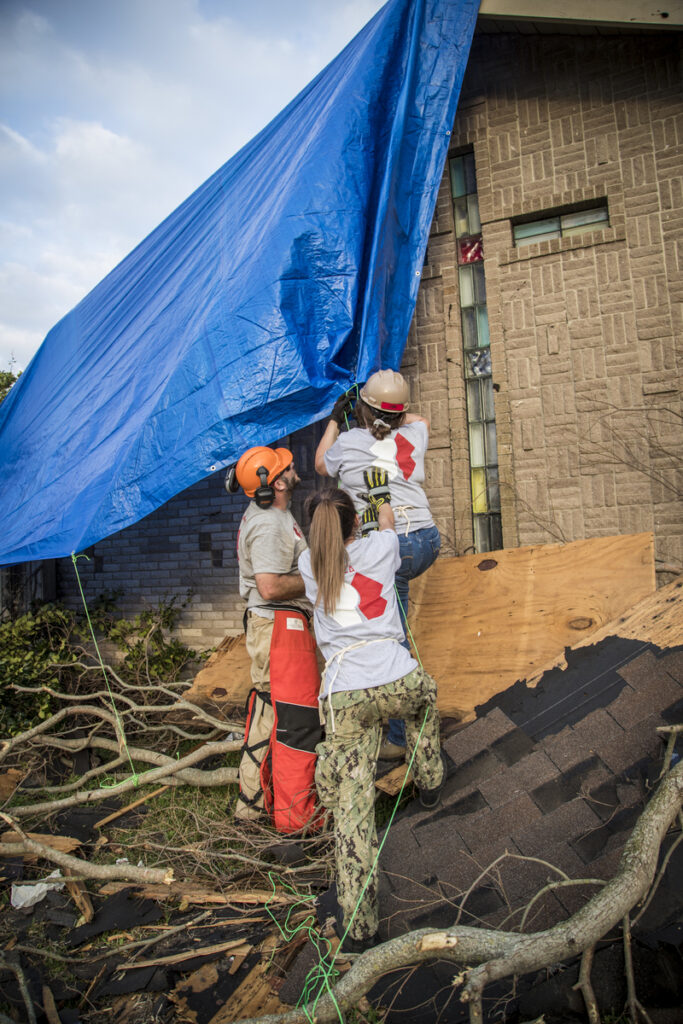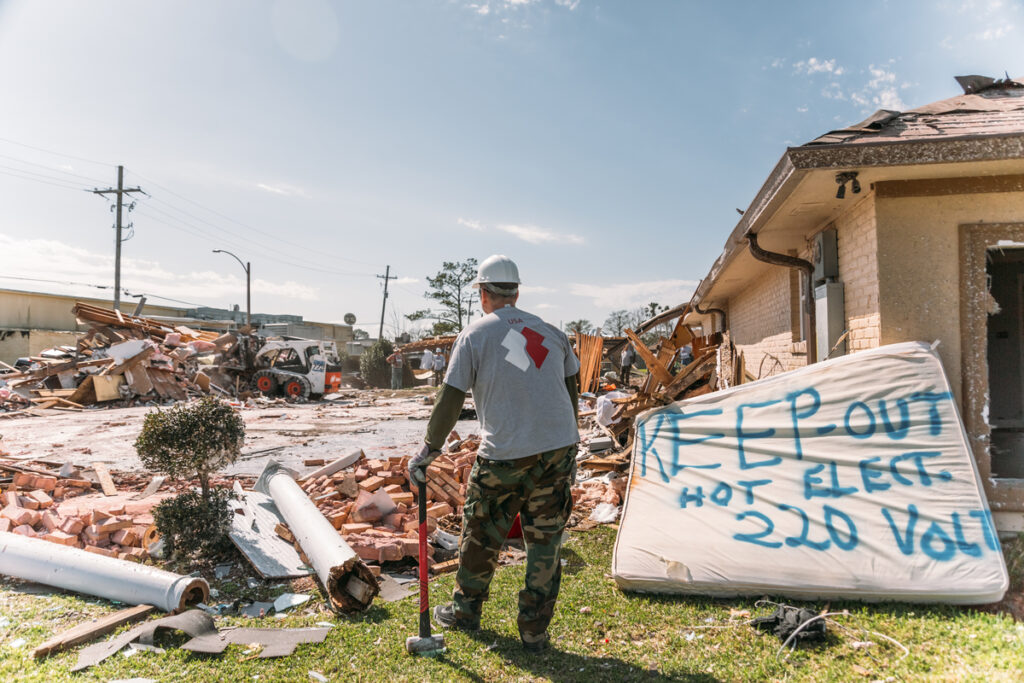Over the past 11 years, Team Rubicon has responded to more than 100 tornadoes. Unpredictable in nature, violent in action, tornadoes typically occur with very little warning—often 13 minutes at most—and with wind speeds that can reach in excess of 300 mph, which is enough to remove some homes from their foundations. That means virtually every Greyshirt who has served as a tornado relief volunteer has seen everything from downed trees blocking homes and driveways to entire city blocks in rubble.
“There is absolutely nothing that will completely prepare you for what you will encounter on your first tornado or windstorm deployment,” says Jessie “Boots” Massaruto, who has responded to eight tornadoes with Team Rubicon, including three that were back-to-back in Tennessee. “That moment you think you’ve seen it all, you haven’t. I have never had the great honor to serve this country, but I’ve volunteered alongside some brave men and women who have, and when you drive up to a home and a veteran you’re serving with tears up and says ‘It looks like a combat zone,’ you know just how powerful a tornado truly is.”
A decade’s worth of work responding to tornadoes does mean Team Rubicon’s disaster relief volunteers—or Greyshirts—know a bit about what to expect in the hours, days, and weeks after a twister strikes and how to prepare to serve in its wake. Five Greyshirts share advice on what to expect when responding to a tornado, and how to prepare to serve.
Random Paths of Destruction, and Long Roads to Recovery
Unpredictable, uncalculated, and with paths of destruction that are impossible to foresee and difficult to track, tornadoes are the most devastating of wind-based disasters for many disaster relief volunteers.
Then there’s the absolute randomness—and infinitesimal localization—of their effects. “You can go into a region that’s been impacted by a tornado and find that one house may be completely destroyed while the house beside it may only have a couple shingles ripped off. It can be that specific,” says Greyshirt and tornado relief volunteer Brian Ackerman, who responded to tornadoes three times in 2020. “One home can be destroyed, but the homes on the left and right are perfectly fine. It’s the strangest phenomenon. You don’t know where a tornado is going to go until the tornado has already happened.”

While tornadoes may only affect pockets of an area and many people may not be affected at all, recovery for the entire community can be slow.
“These types of disasters are a blow to communities that will take months and maybe years to get back a sense of normalcy. The storm damage of a tornado or other windstorm is truly like no other. The number of volunteers and amount of work required in the rebuilding of neighborhoods and cities is a long process,” says Massaruto. “You will experience a variety of emotions when you roll onto the scene of the aftermath, but it is in that moment, you realize your presence will make all the difference in the world to folks whose lives forever changed overnight.”
Many Chainsaws Make Lighter Work
Because tornadoes can rip up and topple trees, or twist them even, experienced sawyers are essential to virtually every tornado response. The more experienced, the better. “Damages caused by windstorms, like tornadoes, will compromise the integrity of a tree and if you are not properly trained as a sawyer, it may cause damage or injuries to property and self,” says Massaruto.
Deploying numerous saw teams in response to a tornado may make the difference in quick route clearance and recovery, too.

“Lots of areas, like here in South Carolina, are all heavy pine trees, and 180 mile-an-hour winds and trees don’t exactly get along,” says Ackerman. On a recent tornado response, Ackerman says Team Rubicon towed away 10,000 cubic tons of wood.
After A Tornado, Disaster Responders Hit the Roof
While a lot of tasks for Greyshirts around tornadoes are saw heavy, there’s isn’t typically a lot of water damage to be handled.
“Because the storms are fast-moving wind, there aren’t deluges of rain,” explains Ackerman. “For that reason, there doesn’t tend to be a lot of muck-out work in the initial hours and day after a tornado, provided a roof hasn’t been breached and the storm wasn’t followed by rain.”
Roof tarping, however, is paramount after a tornado. “People get their roofs blown off, or sections of their roof gets penetrated by trees,” explains Ackerman. In order to prevent rain from infiltrating damaged homes after a tornado, many disaster relief agencies deploy roof tarpers right from the start.
Greyshirts’ Advice to a Future Tornado Relief Vounteer: Be Prepared to Pick Things Up and Put Them Down
Sometimes the work that makes the biggest impact after a tornado isn’t the glamourous stuff. Rather, say these Greyshirts, disaster relief volunteers responding to tornadoes should be prepared to do whatever needs to be done, even if it’s not what they are an expert in.
“The hazards after a tornado are everywhere. Just because you are cleared to run a saw, doesn’t necessarily mean you will on day one. It depends on the work orders. I’ve known sawyers that were strike team leaders for a roof tarping crew all week and never touched a saw,” says Greyshirt Amanda Moore, who has been responding to tornadoes since 2018. “Always be willing to lend a hand where it is needed, even if you’d prefer to do something else. And Semper Gumby (Always Flexible)—be ready for things to change.”

Also, when serving as a tornado relief volunteer, get ready for rubble. “I would say Greyshirts should be ready to move debris. Just the act of starting this [debris removal] gave great relief to the victims,” explains Bonnie Edward, a Greyshirt who responded to an EF-3 tornado in Seneca, South Carolina in April of 2020. “Pick things up and put things down. There is something to say about the benefits of mindless manual labor.”
Expect the Unexpected, and Learn to Keep a Straight Face
Brandon Callahan, a longtime Greyshirt, has seen a few unexpected things over his years of serving as a tornado relief volunteer. When it comes to tornadoes especially, he encourages responders to be prepared to see things they aren’t expecting, in places they don’t typically belong.
Whatever is in a home when a tornado hits will be picked up and scattered across a wide-ranging area, Callahan explains. “We find a lot of things that belong in the bedroom in the fields,” says Callahan. Perhaps finding personal belongings where they don’t belong is no surprise. With an average width of 300 to 500 yards, and a path that could extend up to 50 miles, it’s nothing to find paperwork from a home in one county in a yard the next county over.
When responding to a tornado, come prepared to search for important belongings in unexpected places. “Personal property from homeowners can be blown all over the place. We’ve found personal belongings in nearby forests,” says Callahan. We once found someone’s car about 100 yards away, in the woods behind their house.”
The Hazards Are Random and What You Wear Matters
Because of the wide range of debris left by tornadoes—from nails pulled out of walls to shattered glass—having essential protection, such as gloves and boots, may mean the difference between getting work done and being sidelined by an injury.
“Do not leave home without good boots and gloves,” urges Edward. “I would also say that it is important to look up. There could be so many hazards up in trees or overhead.”
Massaruto—aka Boots—seconds the work gear suggestions and adds one more: “If you need suspenders to keep your pants up, I highly recommend buying a pair before you deploy.”

Want to learn how to prepare for a tornado? Read To Survive a Tornado, Get Low
Want to become a tornado relief volunteer? Join Team Rubicon now.



